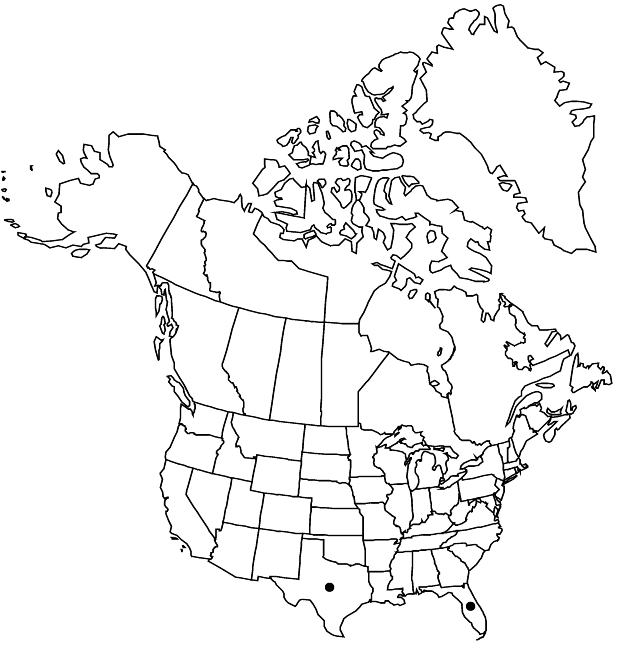Difference between revisions of "Bryophyllum daigremontianum"
in H. G. A. Engler and K. Prantl, Nat. Pflanzenfam. ed. 2, 18a: 412. 1930 ,.
FNA>Volume Importer |
imported>Volume Importer |
||
| (2 intermediate revisions by 2 users not shown) | |||
| Line 1: | Line 1: | ||
{{Treatment/ID | {{Treatment/ID | ||
|accepted_name=Bryophyllum daigremontianum | |accepted_name=Bryophyllum daigremontianum | ||
| − | |accepted_authority=(Raymond-Hamet & H. Perrier) A. Berger | + | |accepted_authority=(Raymond-Hamet & H. Perrier) A. Berger |
|publications={{Treatment/Publication | |publications={{Treatment/Publication | ||
|title=in H. G. A. Engler and K. Prantl, Nat. Pflanzenfam. ed. | |title=in H. G. A. Engler and K. Prantl, Nat. Pflanzenfam. ed. | ||
| Line 29: | Line 29: | ||
|elevation=0 m | |elevation=0 m | ||
|distribution=Fla.;Tex.;Indian Ocean Islands (Madagascar). | |distribution=Fla.;Tex.;Indian Ocean Islands (Madagascar). | ||
| + | |introduced=true | ||
|discussion=<p><i>Bryophyllum daigremontianum</i> is well established and an aggressive weed in southern Florida and in coastal southern Texas. M. G. Groner (1975) found that exudates of its roots can inhibit the growth of nearby plants, as can extracts of its shoots. The entire plant contains bufadienolides and is toxic to cattle (R. A. McKenzie et al. 1987).</p><!-- | |discussion=<p><i>Bryophyllum daigremontianum</i> is well established and an aggressive weed in southern Florida and in coastal southern Texas. M. G. Groner (1975) found that exudates of its roots can inhibit the growth of nearby plants, as can extracts of its shoots. The entire plant contains bufadienolides and is toxic to cattle (R. A. McKenzie et al. 1987).</p><!-- | ||
--><p>The hybrid <i>Bryophyllum daigremontianum</i> × <i>B. delagoense</i> is much like <i>B. daigremontianum</i> but with narrower leaves; some specimens identified as <i>B. daigremontianum</i> may possibly be the hybrid. The hybrid is widely naturalized in Queensland.</p> | --><p>The hybrid <i>Bryophyllum daigremontianum</i> × <i>B. delagoense</i> is much like <i>B. daigremontianum</i> but with narrower leaves; some specimens identified as <i>B. daigremontianum</i> may possibly be the hybrid. The hybrid is widely naturalized in Queensland.</p> | ||
| Line 39: | Line 40: | ||
-->{{#Taxon: | -->{{#Taxon: | ||
name=Bryophyllum daigremontianum | name=Bryophyllum daigremontianum | ||
| − | |authority=(Raymond-Hamet & H. Perrier) A. Berger | + | |authority=(Raymond-Hamet & H. Perrier) A. Berger |
|rank=species | |rank=species | ||
|parent rank=genus | |parent rank=genus | ||
| Line 54: | Line 55: | ||
|publication year= | |publication year= | ||
|special status= | |special status= | ||
| − | |source xml=https:// | + | |source xml=https://bitbucket.org/aafc-mbb/fna-data-curation/src/2e0870ddd59836b60bcf96646a41e87ea5a5943a/coarse_grained_fna_xml/V8/V8_321.xml |
|genus=Bryophyllum | |genus=Bryophyllum | ||
|species=Bryophyllum daigremontianum | |species=Bryophyllum daigremontianum | ||
Latest revision as of 22:42, 5 November 2020
Herbs, monocarpic, purple-mottled, glaucous. Stems mostly simple, terete, 5–25 dm × 0.5–2 cm. Leaves opposite, evenly spaced, simple, largest subpeltate; petiole subterete, 1–5 cm; blade purple-blotched abaxially, triangular to lanceolate, 5–25 × 3–12 cm, margins serrate, apex acute, surfaces glaucous; bulbils borne in notches of leaf margins, spurs spoon-shaped. Cymes lax, paniculate, 1.5–3 dm diam.; branches to 15 cm. Pedicels 5–15 mm. Flowers: calyx green or purplish, not inflated, 6–10 mm, tube 3–4 mm, lobes triangular, 3–7 mm, equaling or longer than tube, apex acute; corolla pink or lavender, 20–30 mm, not contracted basally, lobes obovate, 6–12 mm, apex rounded, apiculate. 2n = 38.
Phenology: Flowering winter.
Habitat: Waste ground, mesquite-cactus thickets
Elevation: 0 m
Distribution

Introduced; Fla., Tex., Indian Ocean Islands (Madagascar).
Discussion
Bryophyllum daigremontianum is well established and an aggressive weed in southern Florida and in coastal southern Texas. M. G. Groner (1975) found that exudates of its roots can inhibit the growth of nearby plants, as can extracts of its shoots. The entire plant contains bufadienolides and is toxic to cattle (R. A. McKenzie et al. 1987).
The hybrid Bryophyllum daigremontianum × B. delagoense is much like B. daigremontianum but with narrower leaves; some specimens identified as B. daigremontianum may possibly be the hybrid. The hybrid is widely naturalized in Queensland.
Selected References
None.